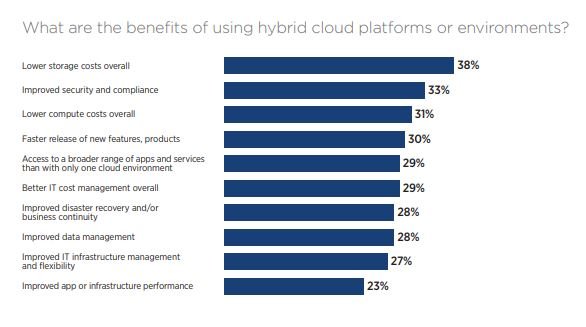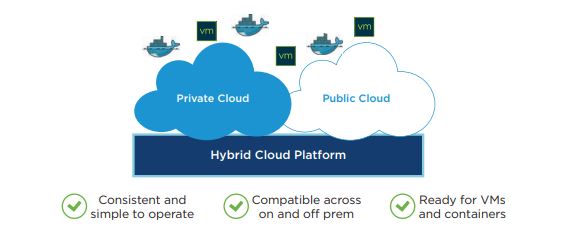
Best Practices for Transitioning to a Modern, Cloud-Ready IT Foundation that Improves Agility, Flexibility, and Costs
Cloud Adoption Is on the Rise in Higher Education
A decade ago, few could have predicted the velocity and impact of change occurring today across academic institutions worldwide. Schools have increasingly diverse student populations. There’s tremendous growth in learning options. Mobile devices are connecting everywhere—on-and off-campus. With no end in sight, what is your institution’s plan to evolve amid rapid change in what defines a digital campus?
If you are expecting progress toward business goals to be catalyzed by modern IT approaches such as cloud that redefine learning, boost IT operational efficiency, and maintain data privacy, there’s good news. Recent advancements in cloud delivery models have addressed multi-cloud management, security, data privacy, and regulatory concerns. So, there’s no better time than now for your academic institution to embrace hybrid cloud services to meet your goals.
Lowering costs, elevating IT service levels, compliance, and disaster recovery are the primary reasons campus IT is choosing multiple cloud platforms today. Speeding up systems of engagement development closely follows, illustrating the ways in which cloud has become central to strategic IT decision making. As more schools and universities embrace modern approaches to teaching and learning—which often requires increased data storage and access to web-based apps and platforms—cloud computing’s popularity is on the rise.
Continue reading to understand why academic institutions facing the growing complexities of integrating new technologies into existing platforms while accommodating legacy applications are choosing hybrid cloud as a best-practice strategy to address critical learning and business requirements.
Why Hybrid Cloud?
For many academic institutions, school-owned data centers remain central to IT operations. A majority of workloads live on-premises, especially legacy business applications and sensitive institutional data. Recognizing that integrating public cloud into current service offerings is not only critical, but also offers economic and operational advantages, academic institutions are looking to shift to a more agile, hybrid cloud model that leverages both private and public cloud to meet business needs.
IT leaders in academic institutions recently reported deploying hybrid cloud can yield significant benefits.

Business Drivers Accelerate Investment
Because cloud is a strategy, not a destination, VMware works closely with higher education IT teams around the world to first identify the top business challenges IT teams anticipate cloud can help solve.
• Research & Development at Lower Cost – Universities want to tap the power and lower-cost capacity of cloud to speed delivery of consistent, secure, and compliant research and development environments. Hybrid cloud offers the flexibility to pay only for consumed resources—from storage to processing power—gaining tremendous efficiency benefits.
• Infrastructure-as-a-Service Portals – Campuses seeking to quickly and easily deliver compute, storage, and networking resources to internal customers, such as individual colleges or departments, are choosing hybrid cloud to make all needed services available through a self-service portal, improving time to delivery of infrastructure from weeks to minutes.
• Consolidate & Modernize Data Centers – Schools dealing with mergers or those part of larger systems, are having to address data center sprawl and workload consolidation. Virtualization and hybrid cloud services are becoming an ideal strategy to eliminate computing silos and expand capacity—all without specific hardware dependencies, moving from a primarily CapEx model toward OpEx.
• Modernize & Migrate Applications – As curriculum demands increase, schools want hybrid cloud to speed the provisioning of new app types such as cloud-native and SaaS without abandoning traditional apps. Too difficult to re-architect or rewrite quickly, legacy apps can be considered for migration to hybrid cloud as an evolution strategy. While significantly reducing effort, cost, and schedules, hybrid cloud helps ensure consistent management and monitoring of all workloads across clouds.
• Enhance Security – Academic institutions seeking ways to detect, mitigate, and prevent brand-damaging breaches are discovering that fully integrated, multilayered security capabilities across clouds and services with multitenancy and policy based governance from trusted partners make running critical or sensitive apps in the cloud more comfortable for them.
• Manage Performance and Contain Costs – Because oversight remains important, universities are looking to proven hybrid cloud providers for the interoperability that enables IT to use existing tools and skill sets to manage across clouds and to easily move apps between private and public clouds as needed.
Yet Concerns Remain
IT organizations in schools of all sizes report security, privacy, and migration of applications and/or data between clouds as top challenges when moving to the cloud. For your institution to achieve cloud computing’s efficiency and cost benefits, it’s imperative to have a good understanding of the needs of your workloads. Otherwise, short-term decisions may prove to be risky and actually set your strategic plans back in the longer term.
Change the Way You Think About Hybrid Cloud
Only when you understand your workloads—and how they translate into meeting your top business requirements for moving to cloud—can you build a strategy to ensure those workloads always have what they need. For example, consider your answers to the following questions:
• Which of your applications are designed to run in multiple data centers?
• How much does it cost to run them, and are there hard-coded hooks into the current infrastructure?
• Are there times when you need more computing resources (e.g., during enrollment or for high performance computing)?
• What applications are best suited for cloud, and which cloud?
• What are the security, compliance, and regulatory implications of migrating applications to the cloud?
Requirements for Hybrid Cloud Success
For public clouds to become a critical element of your modernization strategy, you need a single, consistent, familiar experience across your data center and cloud environments. VMware Cloud provides it.
VMware’s Approach: Hybrid Cloud at Your Academic Institution’s Pace
Cloud-first digital transformation includes adopting a hybrid model that helps grow and streamline your business, so you can effectively compete in a landscape of increasingly efficient, lower-cost, and digital institutions.
VMware Cloud Foundation™, which includes industry-leading VMware vSphere®, VMware vSAN™, and VMware NSX® virtualization technologies, provides the simplest way to build an integrated hybrid cloud. It features a complete set of software and services for compute, storage, networking, security, and cloud management to run enterprise apps—traditional or containerized—in private or public cloud environments. It is easy to operate with built-in automated lifecycle management, providing the ultimate cloud extensibility and freedom.
With VMware, your school can choose the best approach to meet a particular business need, for example, maintain a private cloud on-premises and expand it to the public cloud for DevTest, disaster recovery (DR), seasonal spikes and online learning initiatives, or rely on hybrid cloud to reduce data center footprint or migrate prioritized apps and workloads.

Cloud Progress in Education
If your academic institution isn’t strategizing or already moving to hybrid cloud, you risk being left behind. A full 84 percent of academic institutions recently surveyed have either implemented or are planning to implement hybrid cloud within the next 12 months.

Best Practices for Transitioning Your Institution to Hybrid Cloud
As you progress, there are six best practices to keep in mind to maximize success on your hybrid cloud journey:
1. Modernize your data center to build for cloud.
2. Find a common set of cloud management capabilities that reduces complexity and improves operational efficiency.
3. Make your existing staff an even bigger asset.
4. Stop rewriting education applications or code.
5. Insist that integrated security be a must-have, everywhere!
6. Discover a highly reliable platform that supports cloud adoption at your pace
Learn More about VMware Cloud Solutions for Higher Education
Ever-increasing budget pressures and faster service delivery demands are providing the impetus your IT and business teams need to move cloud strategies forward. And the timing couldn’t be better. There is greater growth in the sophistication, stability, security, and types of cloud applications, solutions, and support services than ever.
As an integral part of their digital transformation strategies, academic institutions worldwide are choosing VMware hybrid cloud solutions to overcome scalability, availability, and budget challenges. They are modernizing IT foundations with VMware to improve learning, teaching, research, agility, speed of service delivery, and security at lower costs.
Familiar VMware technology already in your data center extends to private and public clouds, enabling your on-premises infrastructure to continue to deliver high ROI. Existing teams with the right skill sets are also already in place to move your cloud strategy forward.
Your institution’s ability to continue to attract and retain the best students, educators, staff will depend on IT’s ability to best match data center and cloud solutions to the needs of each application. Following best practices and leveraging continuing advancements in cloud delivery models make now the ideal time to adopt a hybrid cloud solution that accelerates your digital campus plans. ScholarBuys can help guide you through VMware solutions with our expert knowledge of education and license agreements.
Contact one our Academic Technology Experts to learn more or to request a quote!

